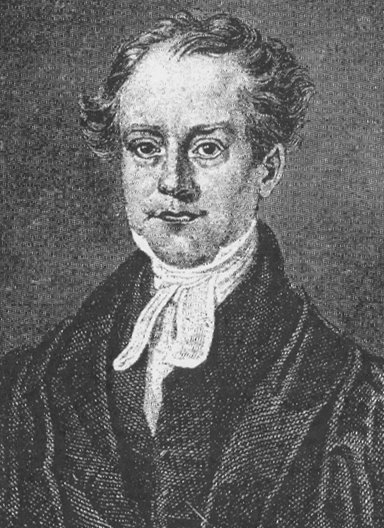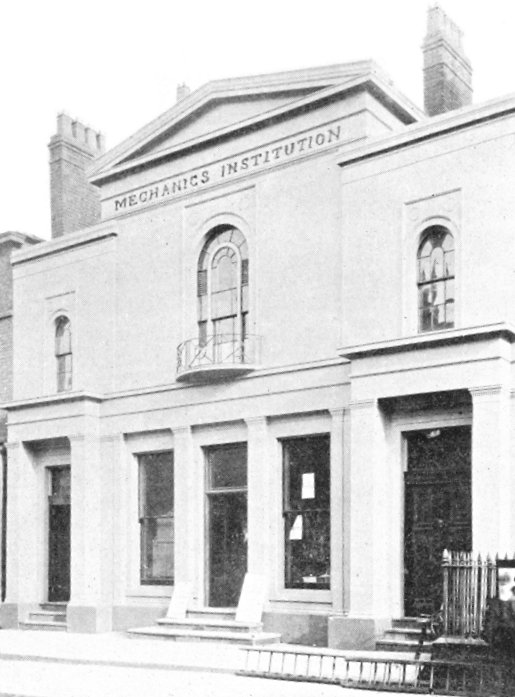| The Mechanics’
Institute The institute began in the same
way as the earlier libraries, on a small scale, in
the front rooms of a house in King Street, in about
1827. The privately owned house was rented for this
purpose and stocked with numerous books, both
entertaining and educational, which were lent out,
in exchange for a quarterly fee. It was hoped that
it would be a way of educating young people, who
could acquire a wide range of knowledge that would
assist them in their working and private lives.
|
| Many of the people involved in the
setting-up of the library had previously been
associated with the setting-up of the earlier
library in King Street and later Queen Street.
In 1835, the management committee decided that a
larger building was essential in order to expand
the service and to provide a facility for
factory workers who could go there in the
evening to improve their education. A
provisional committee was formed to solicit
donations to enable the managing committee to
purchase shares in a new building.
The committee consisted of two bankers,
Alexander Hordern, and Richard Fryer; along with Joseph Pearson,
a brass
founder; Joseph Walker, a nail manufacturer; William
Walker, a merchant; William Shoolbred, a tinplate maker
and japanner; E. H. Coleman, a surgeon; Benjamin
Walton, a tinplate maker and japanner; and two church
ministers, Rev. Stephenson Hunter and Rev. John Roaf,
who was appointed secretary.
They were to receive
the names of people who were willing to become
shareholders in the scheme and to make arrangements
for the erection of the new building. Many prominent
citizens joined the scheme, which raised £1,082. |

The Rev. John Roaf. |
| On the 13th April, 1835, a
piece of land measuring 325 square yards, on the
south side of Queen Street, not far from the
subscription library, was purchased from Mr. T. H.
Ward for £220. Several prominent people agreed to
act as trustees on behalf of the shareholders. They
were: |
| Randle Walker, builder; Henry Walker, hop
merchant; William Walford, architect; Robert
Shoolbred, tailor; Edward H. Coleman, surgeon; T. S.
Simkiss, surgeon; William Walker, factor; Matthew
Ward; Thomas Banks, druggist; George Edwardes,
surgeon; Isaac Fellows, schoolmaster; William Tottey;
and John Banks Nicklin, ironmonger. |
|
At the first meeting of the
shareholders and donors on the 4th May, 1835, the plans
prepared by the architect William Walford were approved
along with contracts for the building work which would
cost £910.18s. The new building was completed by the
beginning of 1836 and included a library room, a reading
room, a lecture room and a dwelling house for the
librarian and caretaker, who would have an annual salary
of £10 and live rent free. |
| The librarian was Mr. Foster. The founders decided
that the rooms were to be let to the subscribers for an
annual rent of £30 and a series of lectures was arranged
for the winter months. Many new books were purchased for
the library, which initially was well used and the
lectures were well attended. Sadly the number of users
began to fall, many letting their membership
subscription go into arrears after about twelve months.
The news and reading rooms that had been well used by
many local shopkeepers and their assistants were soon less
frequented. The institute was soon in debt and many of
the old patrons and supporters moved away. The situation
deteriorated to such an extent that by 1845 the
establishment had more or less closed, with only Mr.
Foster remaining as caretaker, looking after the
premises.
The building was only used occasionally when the
large upper room was hired for concerts and
entertainment or popular lectures. But they were few and
far between. |
 |
Rebirth
In the latter part of 1846, a number of young men,
mainly clerks and shop assistants discussed the
matter of the closure of the institute and felt that
something had to be done to resolve the situation. A
meeting was held in the Star and Garter Hotel on the
22nd January, 1847 to discuss the matter. At the
meeting it was resolved to form a society for the
diffusion of useful knowledge amongst its members, by
the delivery of lectures, public discussions and the
circulation of books.
They decided that the failure
of the institute was due to a lack of sympathy on
the part of the working classes, mainly because the
lectures had been too scientific and at too high a
level. The lectures had failed to provide the
practical knowledge and useful information that
people wanted. After negotiations, the managing
committee of the Mechanics’ Institute expressed
their willingness to cooperate and put the institute
into some form of practical shape. A provisional
committee was formed for the purpose, consisting of
the following members: |
| Thomas Adams, W. S. Darkin,
Samuel Dickinson, Robert Hitchcox, Samuel S. Mander,
John Markham, J. Miller, Mr. Oliver, George
Robertson, W. Trevor, George Young. |
|
They decided to canvass the
town for donations and subscriptions for the purpose
of taking over the books and property of the
institute, re-establishing it and remodelling it on
a broader basis. They also decided that the
membership fee should be ten shillings per year, or
two shillings and six pence per quarter and that the
name should be changed to the Wolverhampton
Athenaeum and Mechanics’ Library. The trustees of
the institute agreed to the proposals and a new
tenancy agreement and an enlarged set of rules were
drawn-up. There were to be courses of lectures on
useful and interesting subjects, with no mention of
controversial matters such as religion or politics.
The committee arranged a
meeting around the end of February 1847 in the large
lecture room, to deliver their report. It was stated
that about 100 people had paid their first
quarter’s subscription as members, but the old
institute still owed a lot of money. They then
appointed the new management committee. The members
were as follows: |
|
President – Mr. E. H. Coleman; Vice-President –
Mr. Henry Crane. Committee members:
Edward Banks, W. S. Darkin, W. Parke, Thomas
Wilkinson Shaw, Robert Shoolbred and Bernard
Walker. Hon. Members: Thomas Adams, Aaron
Atherton, Samuel Dickinson, Alfred Hinde, Robert
Hitchcox, John Jones, George Lancaster, Samuel
S. Mander, John Markham, E. Morris, J. Peace, W.
Trevor, Kempson walker and George Young. The
Secretary was Mr. John Tyrer and the auditors
were Mr. E. D. Shaw and Mr. James Simkiss. |
|
It was agreed that a
subscriber should be allowed to bring a
friend to the lectures and that the reading rooms were to be opened daily
(except Sundays) from 10 am to 10 pm and the
library from 8 am to 10 pm.
The building soon
re-opened and Mr. Foster continued in his
role as librarian and caretaker. He worked
extremely hard for his salary, cleaning the building,
lighting the fires when necessary, providing
coal at his own expense, bringing the
newspapers from the nearest railway station
(then at Heath Town) and placing them on the
tables to be read, keeping the accounts,
delivering notices to members, collecting
unpaid subscriptions and books that had not
been returned, putting details of lectures
on the notice boards and inspecting members’
cards before admitting them to the lecture
room. Unsurprisingly he asked for an
increase in salary, which was denied. The
committee did agree to relieve him of the
burden of buying coal, but that was all. |
| A series of lectures was arranged, but
many were still at too high a level. They
included talks on ‘The Genius and
Perseverance of Great Men in Overcoming
Difficulties’, ‘The Habits and Habitations
of the Midland Manufacturing Districts’ and
‘Animal Mechanics’.
It was found that the rooms on the ground
floor were too small and so the committee
arranged for the trustees to become tenants
of the whole building at an annual rent of
£80. To offset this, the lecture room was
sub-let for talks etc.
By the end of 1847, the annual income was
just over £200 and at the annual meeting in
January 1848 it was stated that the debt had
been reduced. At the meeting in January
1850, it was stated the library was
well-attended with a large demand for books,
but the number of subscribers was falling.
The library contained 1,456 books.
4,500 periodicals had been circulated during
the previous year and the finances were
adequate, but this state of affairs was not
to continue. |

Samuel Dickinson. |
|
By January 1851 there were 371
members, 1,580 books in the library, and over the
previous 12 months, books had been loaned out 2,200
times. At the meeting in January 1853, complaints were
made against Mr. Foster, who had many outside interests
and was not devoting sufficient time to the institute, so
he was given three months notice and adverts were placed
for a successor, who would receive an annual salary of
£40 plus a 10 percent commission on all subscriptions
collected by him and work solely for the institution. This
appears to have been a success. Thanks to the efforts of
the new librarian, the income increased as did the
circulation of books.
All went well for a time, but at a
committee meeting in August 1858 it was stated that the
institution was not receiving the support from the
public that it deserved. The committee had tried hard to
remedy this by enlarging and improving the newsroom and
the library, as well as starting classes for maths and
chemistry. Most people could not afford the membership
fee and the institute entered a period of decline and
stagnation. |
 |
|
 |
|
 |
Return
to
Early Libraries |
|
Return to
the contents |
|
Proceed to the
Working Mens' College |
|